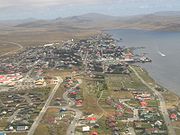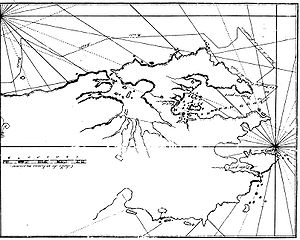
Moody Brook
Encyclopedia


Stanley Harbour
Stanley Harbour is a large inlet on the east coast of East Falkland island. A strait called "the Narrows" leads into Port William.It serves the town of the same name - Stanley - as a harbour. Stanley has sprawled along the south shore of the harbour, to gain shelter from the low hill of Stanley...
on East Falkland
East Falkland
East Falkland the largest of the Falkland Islands in the South Atlantic, has an area of and a coastline long. Most of the population of the Falklands live in East Falkland, almost all of them living in the northern half of the island...
, Falkland Islands
Falkland Islands
The Falkland Islands are an archipelago in the South Atlantic Ocean, located about from the coast of mainland South America. The archipelago consists of East Falkland, West Falkland and 776 lesser islands. The capital, Stanley, is on East Falkland...
. It is near Stanley
Stanley, Falkland Islands
Stanley is the capital and only true cityin the Falkland Islands. It is located on the isle of East Falkland, on a north-facing slope in one of the wettest parts of the islands. At the 2006 census, the city had a population of 2,115...
, just to the north west, and was formerly the location of the town barracks, which were attacked in Operation Azul, the 1982 Argentine Invasion of the Falkland Islands.
It is named after Governor Richard Moody
Richard Moody
Major-General Richard Clement Moody was a Lieutenant-Governor, and later Governor, of the Falkland Islands, and the first Lieutenant-Governor of the Colony of British Columbia. While serving under this post, he selected the site of the new capital, New Westminster...
.
Attack on Moody Brook barracks
Giachino's party had the shortest distance to go: two and a half miles due north. Moody Brook Barracks, the destination of the main party, was six miles away, over rough Falklands terrain. Lieutenant-Commander Sanchez-Sabarots, in the book The Argentine Fight for The Falklands, describes the main party's progress in the dark:- It was a nice night, with a moon, but the cloud covered the moon for most of the time.... It was very hard going with our heavy loads; it was hot work. We eventually became split up into three groups. We only had one night sightNight vision gogglesA night vision device is an optical instrument that allows images to be produced in levels of light approaching total darkness. They are most often used by the military and law enforcement agencies, but are available to civilian users...
; the lead man, Lieutenant Arias had it. One of the groups became separated when a vehicle came along the track we had to cross. We thought it was a military patrol. Another group lost contact, and the third separation was caused by someone going too fast. This caused my second in command, Lieutenant Bardi, to fall. He suffered a hairline fracture of the ankle and had to be left behind with a man to help him. … We were at Moody Brook by 5.30 a.m., just on the limits of the time planned, but with no time for the one hour's reconnaissance for which we had hoped.
The main party of Argentine Marines assumed that the Moody Brook Barracks contained sleeping Royal Marines. The barracks were quiet, although a light was on in the office of the Royal Marine commander. No sentries were observed, and it was a quiet night, apart from the occasional animal call. Lieutenant-Commander Sanchez-Sabarots could hear nothing of any action at Government House, nor from the distant landing beaches; nevertheless, he ordered the assault to begin. Lieutenant-Commander Sanchez-Sabarots continues his account:
- It was still completely dark. We were going to use tear-gasCS gas2-chlorobenzalmalononitrile is the defining component of a "tear gas" commonly referred to as CS gas, which is used as a riot control agent...
to force the British out of the buildings and capture them. Our orders were not to cause casualties if possible. That was the most difficult mission of my career. All our training as commandos was to fight aggressively and inflict maximum casualties on the enemy. We surrounded the barracks with machine-gun teams, leaving only one escape route along the peninsula north of Stanley Harbour. Anyone who did get away would not able to reach the town and reinforce the British there. Then we threw the gas grenades into each building. There was no reaction; the barracks were empty.
The noise of the grenades alerted Major Norman to the presence of Argentines on the island, and he thus drove back to Government House. Realising that the attack was coming from Moody Brook, he ordered all troop sections to converge on the house to enable the defence to be centralised.
Although there were no Royal Marine witnesses to the assault, descriptions of the state of Moody Brook barracks afterward contradict the Argentine version of events. After the action, some of the Royal Marines were allowed to return to barracks to collect personal items. Major Norman describes walls of the barracks as riddled with machine gun fire and bearing the marks of white phosphorus grenades - "a classic housekeeping operation".

